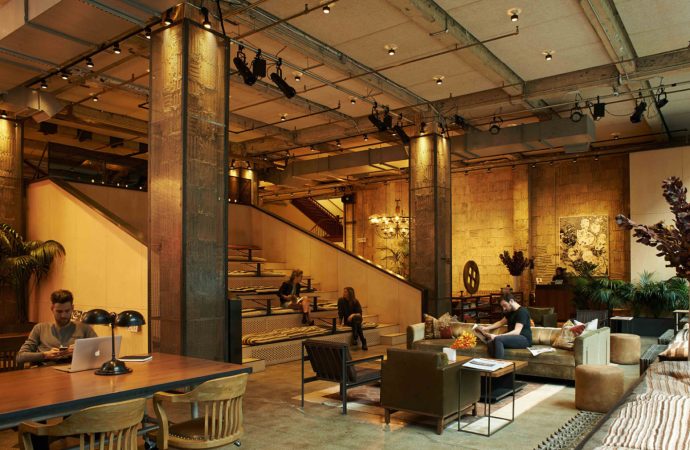The Evolution of Workspaces The traditional office, characterized by its cubicles and structured work hours, is a fading relic of the past. The rapid advancement of technology, along with a shift in work culture, has led to a remarkable transformation in the way we perceive and utilize workspaces. This transformation is epitomized by the rise
The Evolution of Workspaces
The traditional office, characterized by its cubicles and structured work hours, is a fading relic of the past. The rapid advancement of technology, along with a shift in work culture, has led to a remarkable transformation in the way we perceive and utilize workspaces. This transformation is epitomized by the rise of co-working spaces, which are revolutionizing the conventional concept of offices.
Co-Working Spaces Defined
Co-working spaces represent a flexible and shared work environment where professionals from various fields converge to work, collaborate, and innovate. These spaces offer a spectrum of options, from private offices to communal areas, meeting rooms, and event spaces, catering to the diverse needs of today’s workforce.
Why Co-Working Spaces Are Thriving
The remarkable growth of co-working spaces can be attributed to several compelling factors that align with the evolving nature of work:
Flexibility and Affordability
Co-working spaces have disrupted the traditional office leasing model by offering flexible membership options. This allows individuals and businesses to adjust their workspace needs as required, eliminating the constraints of long-term commitments and high overhead costs.
Community and Networking
Co-working spaces create a unique sense of community and foster collaboration. With a diverse mix of professionals working under one roof, these spaces become hubs of innovation and networking. Serendipitous encounters often lead to meaningful connections and unexpected opportunities.
Amenities and Services
Beyond just providing desks, co-working spaces offer a comprehensive package of amenities. High-speed internet, printing facilities, well-equipped kitchen areas, and quality coffee services are commonly available. This level of service allows members to focus on their work, while the space management takes care of the rest.
Location and Accessibility
Many co-working spaces strategically position themselves in urban centers, ensuring easy access to transportation, dining options, and entertainment. The convenience of these locations enhances work-life balance and reduces the time and stress of commuting.
The Co-Working Experience
Entering a co-working space is not just about securing a desk; it’s about becoming part of a dynamic community. Here’s what you can expect from the co-working experience:
- Diverse Work Areas: Co-working spaces offer a range of working environments, from quiet, focused zones to collaborative spaces designed to encourage interaction and innovation.
- Event Spaces: These spaces often include dedicated areas for workshops, seminars, and other events, making it easier to host or attend professional gatherings.
- Meeting Rooms: Whether you need a space for client meetings or team discussions, co-working spaces typically provide bookable meeting rooms equipped with essential technology.
- Fully Equipped Kitchen: Communal kitchen areas provide a space to enjoy meals and snacks. Sharing a meal with fellow co-workers often leads to valuable connections and collaborations.
- Community Managers: Many co-working spaces employ community managers who serve as dedicated points of contact for assistance and community-building. They play a crucial role in creating a sense of belonging among members and ensuring the seamless operation of the space.
Photo by Pixabay: https://www.pexels.com/photo/three-people-sitting-beside-table-416405/
Comparative Analysis: Traditional Office vs. Co-Working Space
Let’s explore a detailed comparison between a traditional office and a co-working space to highlight the significant distinctions:
| Aspect | Traditional Office | Co-Working Space |
|---|---|---|
| Fixed Leases | Traditional offices often involve long-term leases and commitments. | Co-working spaces offer flexible, month-to-month memberships, allowing for scalability and cost-effectiveness. |
| Isolation | Traditional offices can be isolating, with limited interaction. | Co-working spaces thrive on community and networking, fostering collaboration and serendipitous connections. |
| Cost | Traditional offices come with high overhead, including rent, utilities, and maintenance costs. | Co-working spaces are cost-effective, offering inclusive amenities like internet, utilities, and cleaning services. |
| Customization | Traditional offices offer limited flexibility in terms of office design and layout. | Co-working spaces allow for personalized workspace options, catering to individual or team preferences. |
The Commercial Impact of Co-Working Spaces
Co-working spaces are not just transforming work environments; they are reshaping the commercial landscape. Here’s a glimpse into their commercial impact:
Cost-Effective Solutions
Co-working spaces offer businesses a cost-effective alternative to traditional offices. They eliminate the need for large upfront investments in office space and infrastructure, making it easier for startups and small businesses to operate efficiently.
Fostering Innovation
The diverse community within co-working spaces fuels innovation. Professionals from various backgrounds and industries share ideas, collaborate on projects, and offer a unique blend of perspectives, which often results in creative solutions and groundbreaking innovations.
Facilitating Collaboration
Co-working spaces are designed to encourage collaboration. The shared spaces, communal areas, and networking events create an environment that naturally fosters teamwork and knowledge exchange.
Diversity and Inclusivity
Co-working spaces embrace diversity and inclusivity. They provide a platform for professionals of all backgrounds, regardless of their industry, to come together and work in a supportive and inclusive environment.
Conclusion
In conclusion, co-working spaces are revolutionizing the traditional concept of offices. They provide an environment that encourages community, networking, and innovation while offering a cost-effective alternative to traditional office spaces. Furthermore, they are reshaping the commercial landscape by providing businesses with innovative solutions that foster collaboration and inclusivity.
Join the movement and experience the transformation of workspaces firsthand. Whether you’re an entrepreneur, freelancer, or a corporate professional, co-working spaces are designed to cater to your ever-changing needs. Welcome to the world of shared spaces and shared success, where the co-working evolution is driving innovation and changing the way we work.


















Leave a Comment
Your email address will not be published. Required fields are marked with *